Well, the season is now upon us… what season, do you ask? Elderberry season! This extremely important wild plant is edible and has wonderful herbal properties. It starts getting ripe berries any time from July to September, depending on your specific location and elevation. Before the berries, however, come the flowers, which are an amazing treat in and of themselves. Let’s go foraging for elderberries and elderflowers!
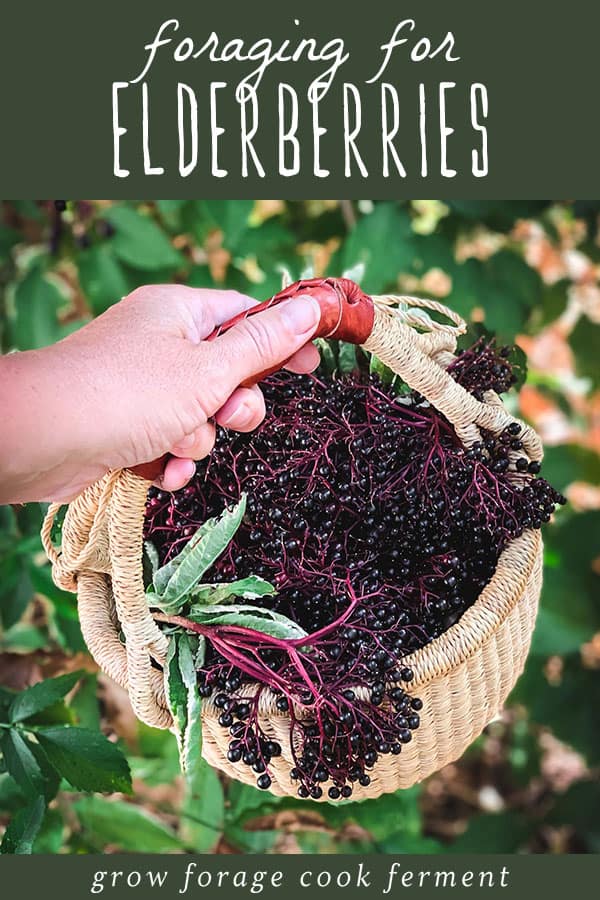
Want to save this post for later?
Wildcrafting Weeds
If you want to learn more about the edible and medicinal weeds that surround us and how to use them, check out my eBook: Wildcrafting Weeds: 20 Easy to Forage Edible and Medicinal Plants (that might be growing in your backyard)!
Elderberry (Sambucus spp.) Varieties
There are three main types of elder: black elder (Sambucus nigra), blue elder (Sambucus nigra subsp. cerulea), and red elder (Sambucus racemosa).
The focus of this article will be foraging for blue and black elderflower and elderberry, as they are the two that are most commonly foraged and used.
Red elder is found across North America, but produces berries which are highly toxic if eaten raw. Red elderberries must be cooked prior to eating.
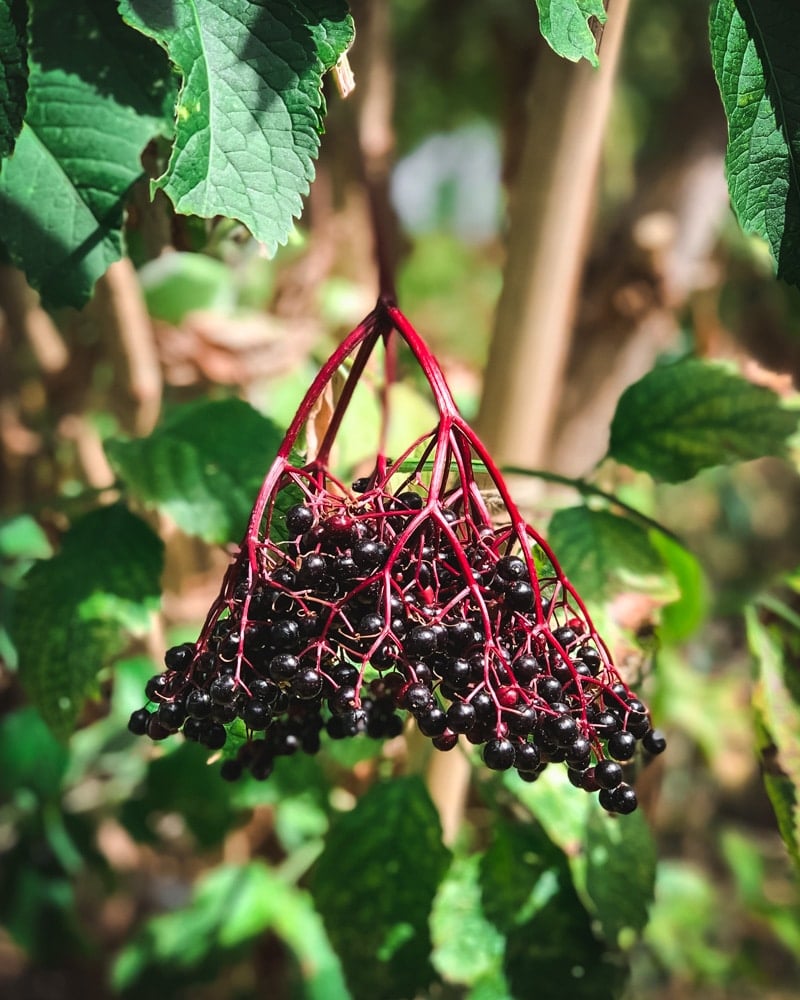
Where and When to Find Elder
Elder species grow all over the world, but are most bountiful in the Northern Hemisphere.
Black elder (Sambucus nigra) is native to Europe but has migrated to the eastern half of North America.
American Black elder (Sambucus nigra subsp. canadensis) is native to eastern North America and is very closely related to black elder.
Blue elder (Sambucus nigra subsp. cerulea) which is another subspecies of black elder, is native to western North America and naturally occurs west of the Rocky Mountains.
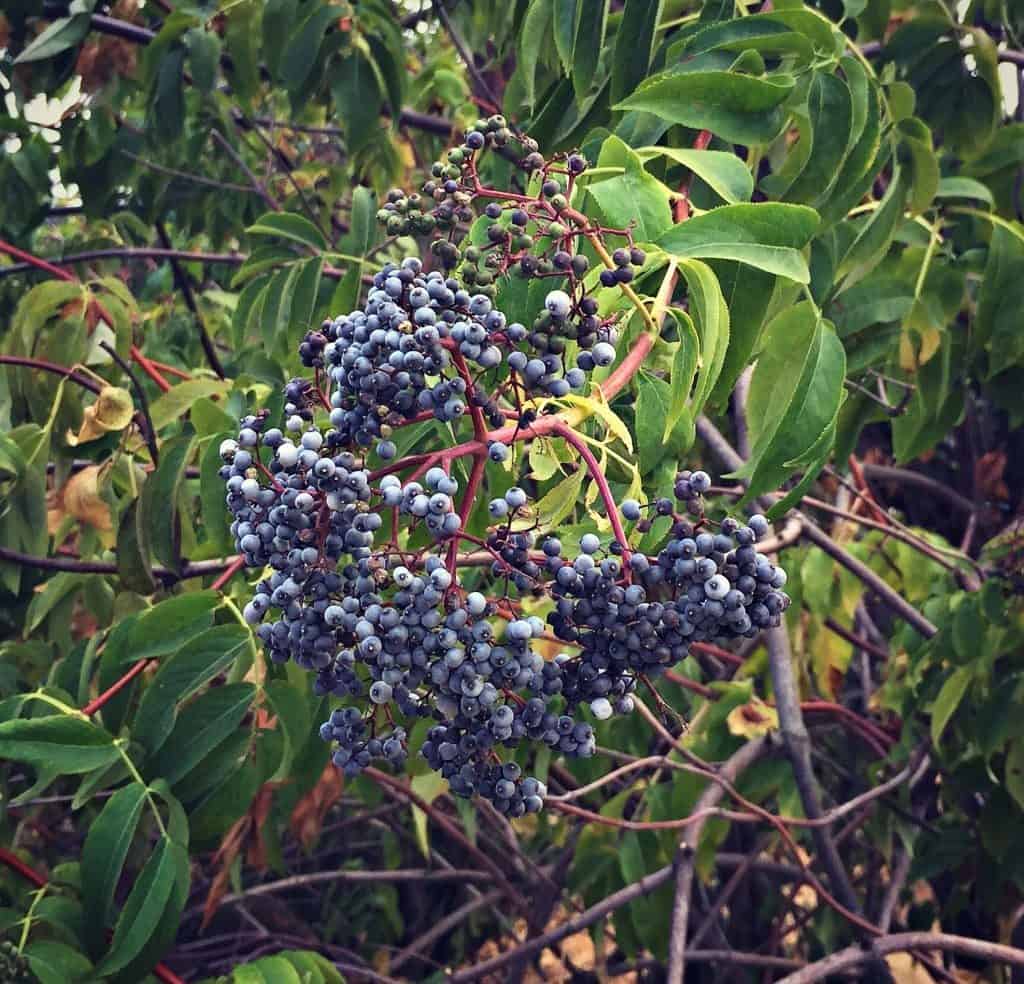
Elder shrubs are commonly found growing wild in disturbed areas, along roadsides, hedgerows, and in areas that have been recently burned.
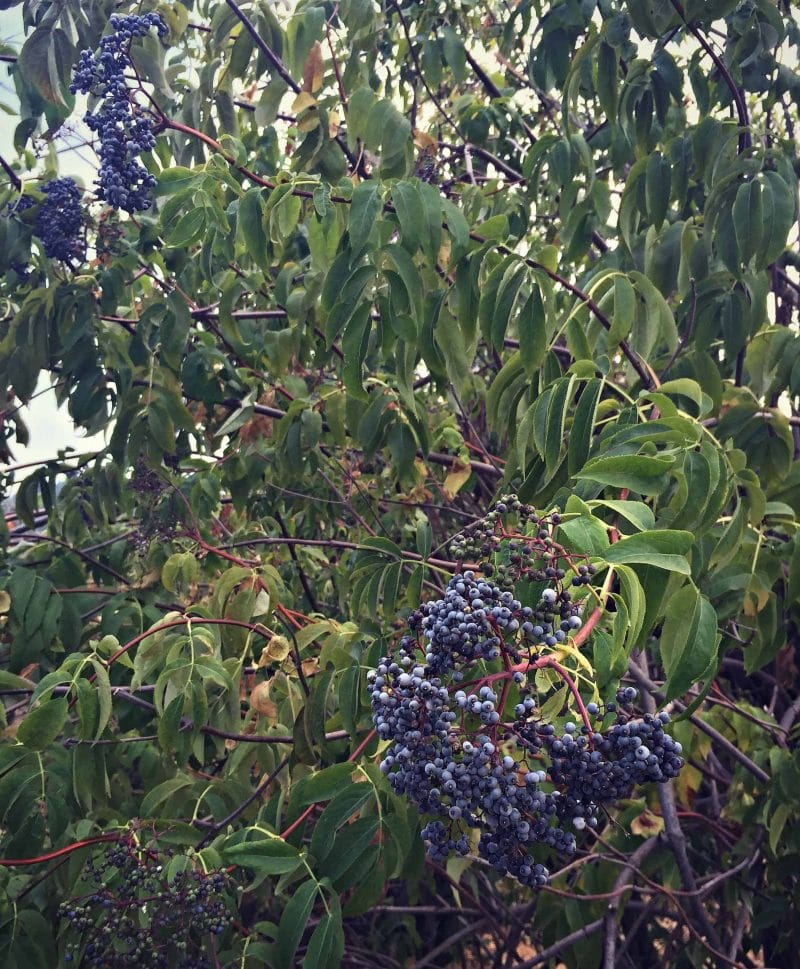
When to Find Elderflower
Elderflowers, which bloom on the shrubs before the berries form, make their first appearance in early springtime and will continue to bloom through July.
Blooming time depends on climate and elevation, with warmer climates seeing flowers as early as March or April and cooler climates not seeing flowers until July.
In southern Oregon elderflowers bloom in late May through June.
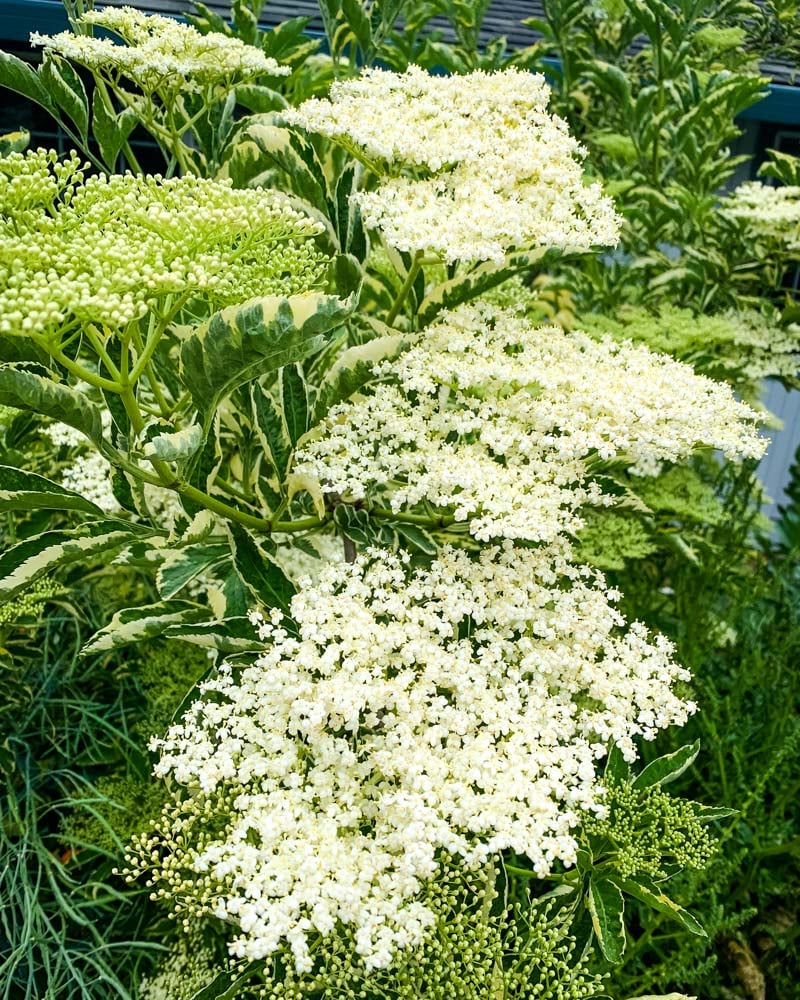
When to Find Elderberry
While partially dependent on climate and where you’re geographically situated, elderberries are typically ready to harvest from July through September. Ours are typically ready by mid-August.
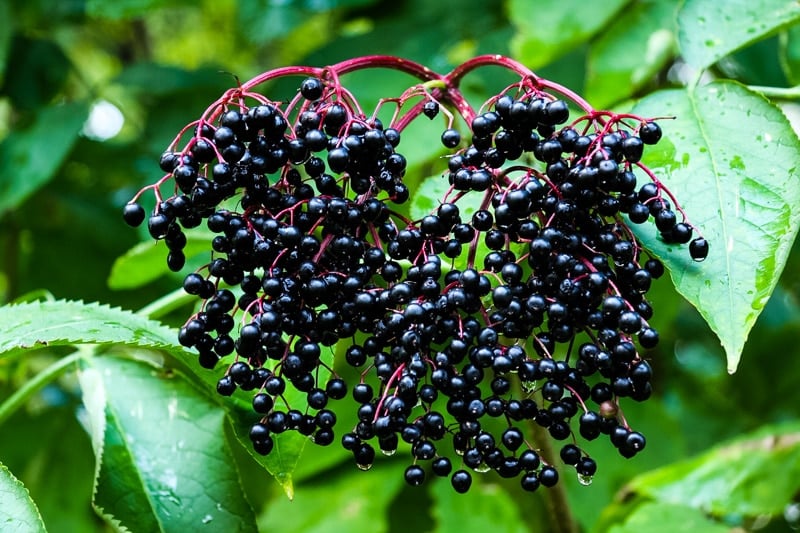
Identifying Elder
Elders are medium to large shrubs with multiple branching systems that can potentially grow to the size of a small tree.
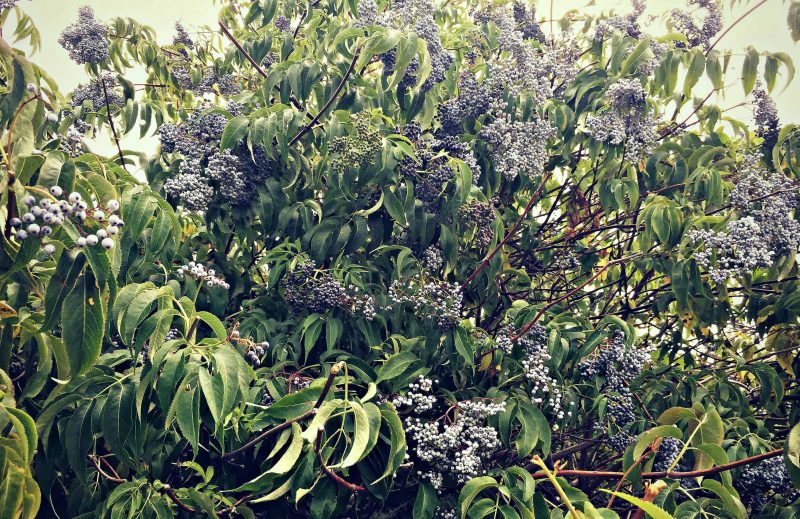
The leaves are opposite, compound, and serrated across all species, a trait that is common across all species which makes elders fairly easy to identify.
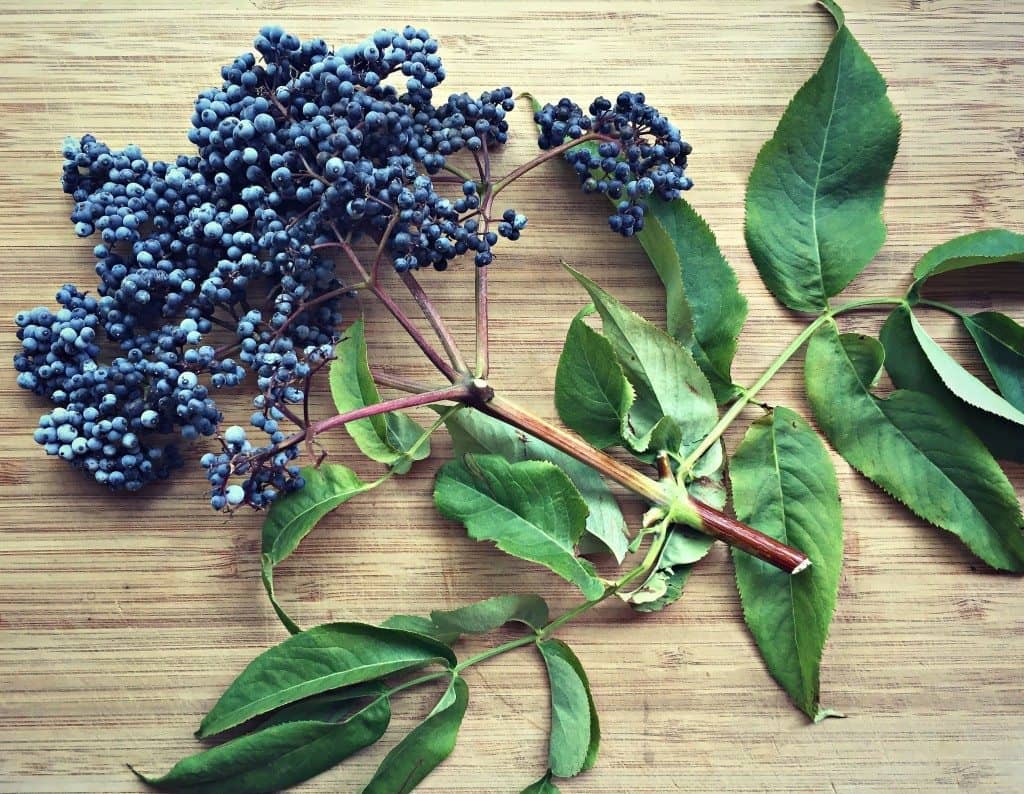
Identifying Elderflower
Elderflowers are a creamy white color and grow in clusters.
These clusters are large and flat (umbel shaped) and each cluster is made up of many tiny flowers. Red elders have cone shaped flowers.
Each individual bloom has five petals and an abundance of yellow pollen on the stamen.
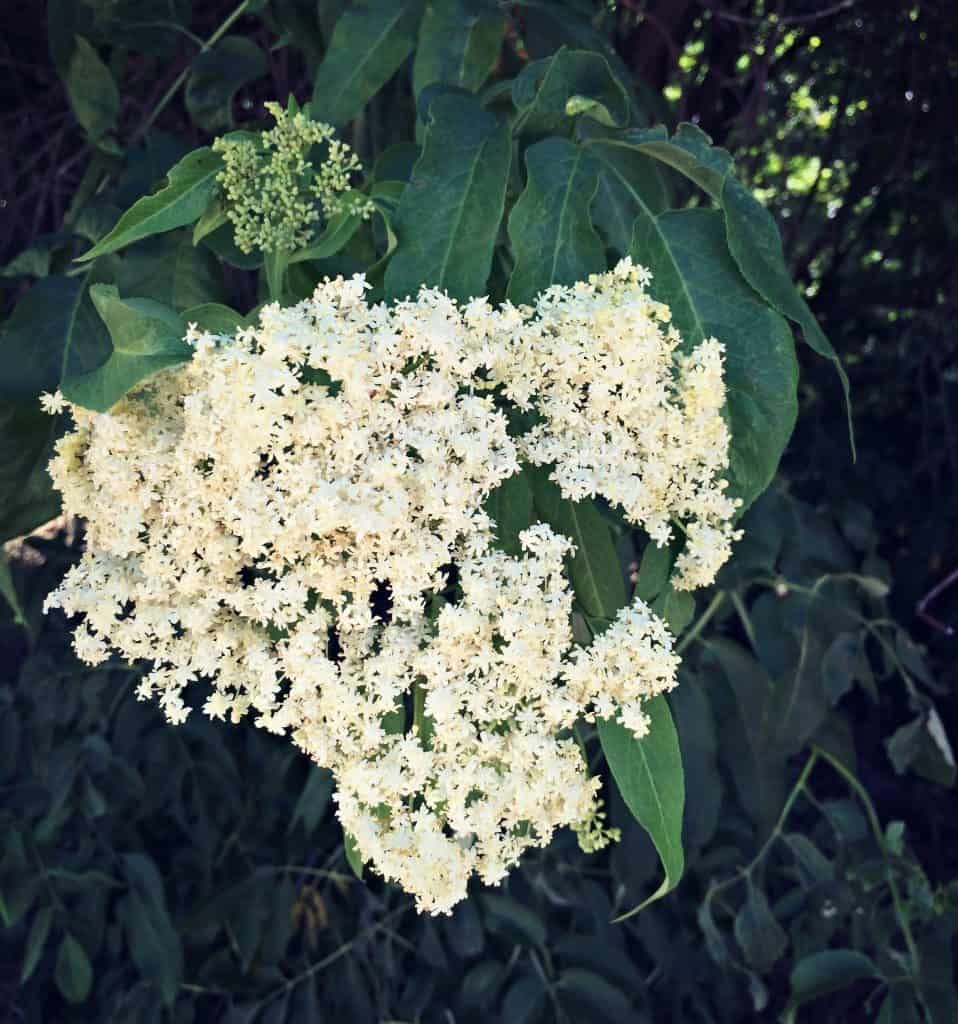
Identifying Elderberry
Black elderberries range in color from dark purple to black and grow in clusters on reddish stems.
Blue elderberries are a deep blue color and are coated in a white bloom of yeast when they’re ripe. This bloomy layer makes it easy to differentiate blue elderberries from black elderberries.
Red elders have bright red berries that grow in a cone-like shape.
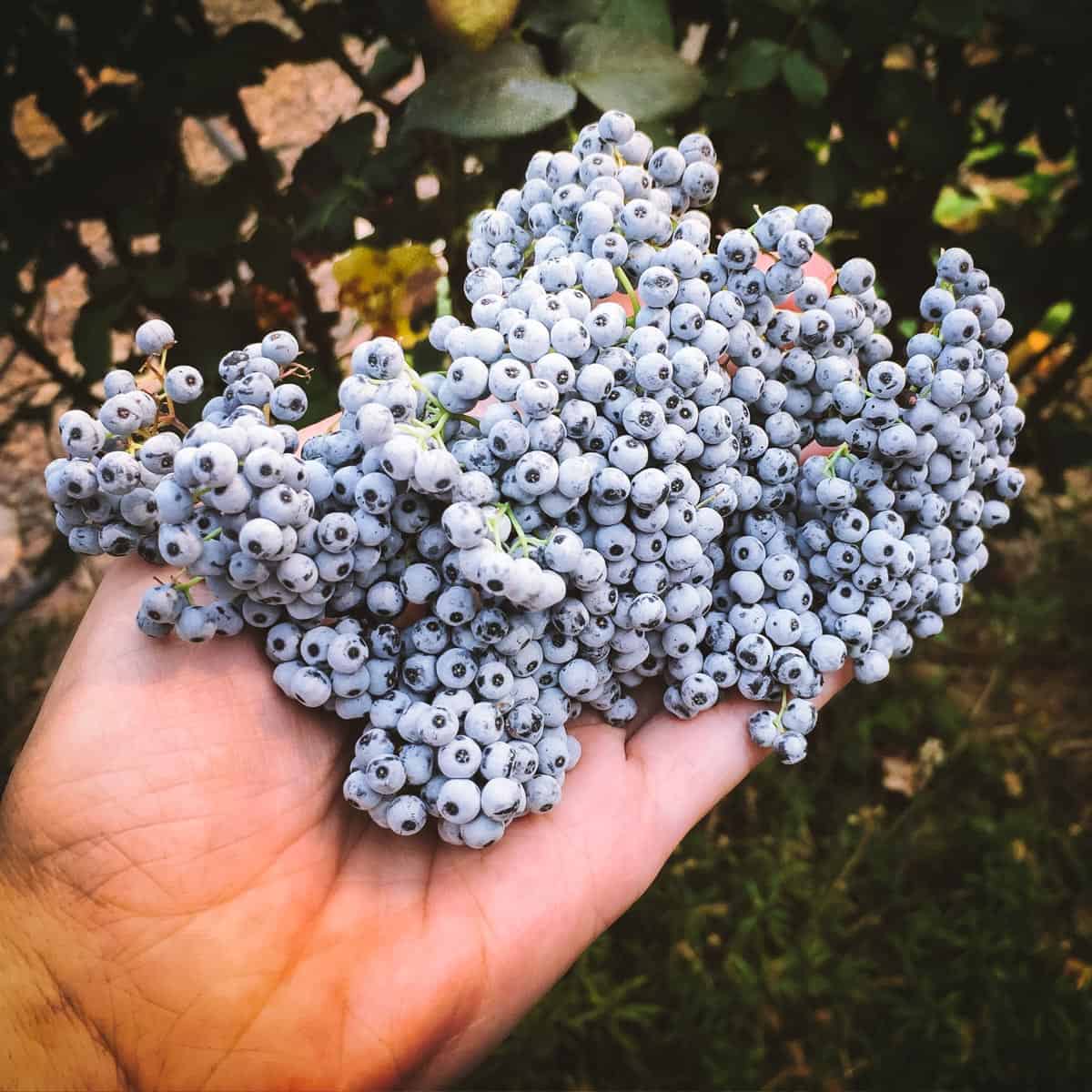
Harvesting Elder
As with any type of foraging, always get permission to harvest elders before taking any of the flowers or berries.
If I’m foraging on a friend or neighbor’s property, I like to show my appreciation by dropping off a gift made from whatever I harvested.
Harvesting Elderflower
When harvesting elderflowers look for fresh flowers that are fully opened but haven’t begun to brown yet.
Flowering elders are almost impossible to miss, the gorgeous blooms truly make the shrub stand out!
Never take more than 20 to 30 percent of the flowers on any given elder plant as the flowers will eventually become berries.
You can dry elderflowers using a flower drying screen or by hanging the bunches upside down.

Harvesting Elderberry
Blue and black elderberries should always be harvested when they’re completely ripe, as unripe berries are toxic. Be aware that elderberry stems and leaves are also toxic and should not be consumed at all.
Freeze whole clusters of elderberries on a large baking sheet in a single layer to make it easier to remove the berries from the stem.
Elderberries can also be hung up to dry or spread out on a drying screen for later use.
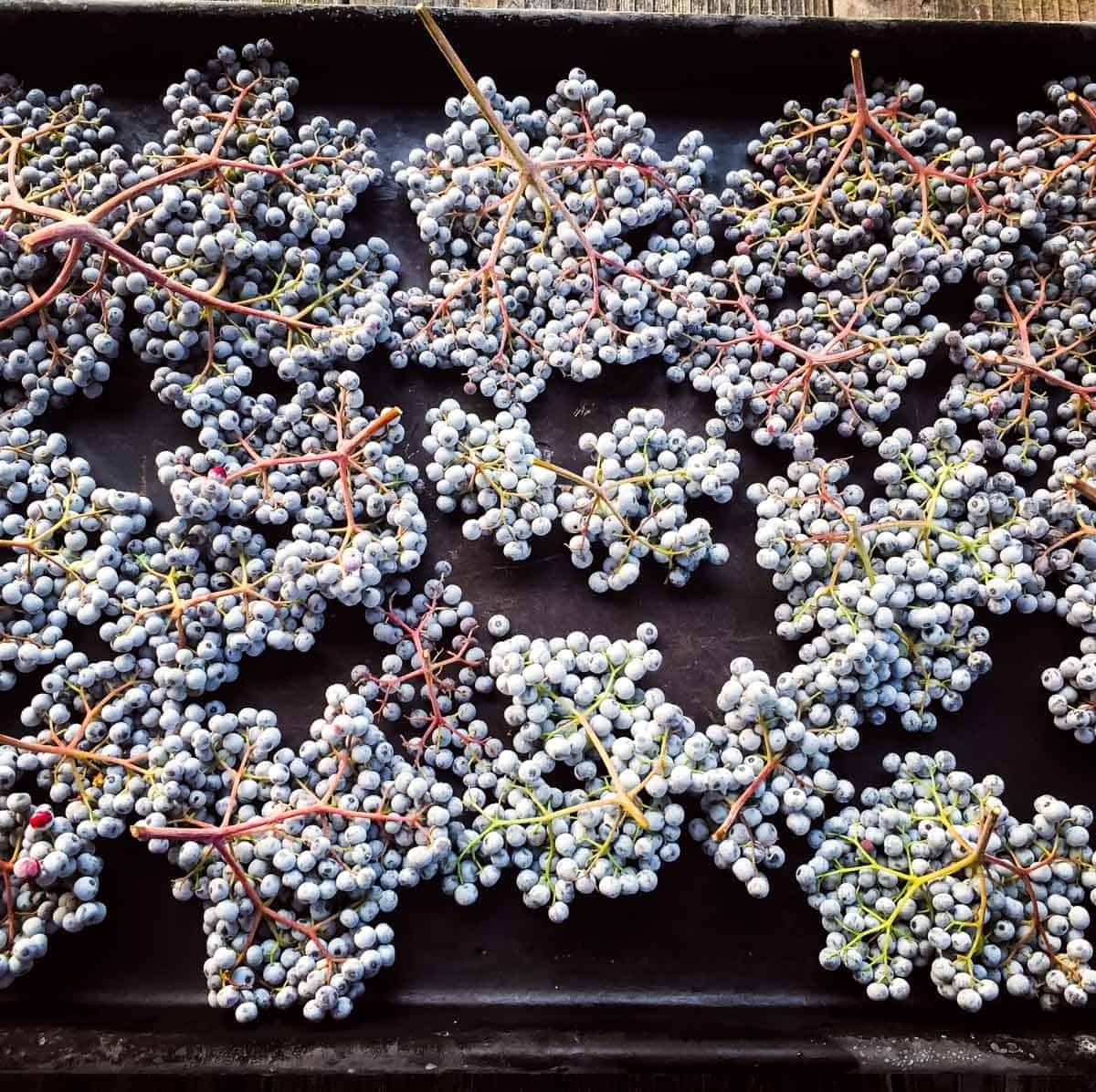
Elder Look-alikes
Depending on whether you’re harvesting elderflowers or elderberries, there are a couple of look-alikes you should be aware of when you’re out foraging.
I always recommend getting a foraging guidebook to help you properly identify plants.
Elderflower Look-alikes
Elderflowers can potentially be mistaken for poison hemlock (Conium maculatum) despite having only a passing resemblance.
Elder shrubs are much larger than poison hemlock, and the blooms on poison hemlock are a true umbel shape with purple spots on the stems.
Take a look at my in-depth guide to identifying poison hemlock if you have any concerns about confusing the two plants while foraging.
Elderberry Look-alikes
When foraging for elderberries, there are two look-alikes to keep in mind.
The first look-alike is called pokeweed (Phytolacca americana), a plant that produces larger berries that hang in a long cylinder.
Pokeweed is highly toxic and is reported to have a highly unpleasant taste — make sure you steer clear of these berries.

The second look-alike plant is called devil’s walking stick (Aralia spinosa); these berries are similar in appearance to elderberries, but the main stem has large thorns.
Unlike pokeweed, the berries on devil’s walking stick are only mildly toxic, but still not something you’d want to consume.
Edible Uses of Elder
Black and blue elderflowers and elderberries are both edible and have a wide array of culinary uses.
It’s important to remember that elder stems, leaves, and unripe berries are toxic and should not be consumed.
Black and blue elderberries sometimes have a small amount of toxicity when consumed raw, mainly in the seeds, which can cause stomach upset in some people.
Edible Uses of Elderflower
Elderflowers are a rich source of nutrients, especially essential fatty acids. To prepare elderflowers for eating, remove the flowers from the stem before using.
Elderflowers are mildly sweet in flavor, making them a delicious addition to homemade muffins, cakes, bread, cookies, ice cream, jelly, and syrup.
Elderflowers are a natural fit for beverages such as tea, lemonade, liqueur, cordial, or kombucha.
When I have an abundance of elderflowers I love to make this sparkling elderflower mead (you can also use the flowers when brewing wine and champagne).
If you’re feeling fancy, you can make your own elderflower liqueur and add it to champagne for a different spin on a French 75 cocktail.
Elderflower fritters are a simple yet elegant way to enjoy the fruits of your foraging endeavors, simply dip the blooms in crepe batter (or follow this recipe for elderflower fritters) and fry until golden and crispy.
Looking for more edible elderflower inspiration? I’ve put together a list of 20+ elderflower recipes for you to try the next time you’re flush with these versatile blooms!

Get recipes using wild violet, lilac, forsythia, chive, calendula, lavender, white clover, nasturtium, elderflower, yarrow, rose, and Queen Anne’s lace flowers in my ebook Edible Flower Recipes: Infusions, Syrups, Jellies, Beverages, & Snacks!
Edible Uses of Elderberry
Elderberries are a tasty fruit with a variety of herbal properties that are easily accessible when used in recipes. There are many options!
Blue and black elderberries can be eaten raw, however some people find that uncooked elderberries cause an upset stomach (red elderberries must be cooked before being ingested).
The white bloom that forms on blue elderberries can also be used to make your own wild yeast starter.
As with any other edible berry, elderberries can be used to make jams, jellies, pies, and syrups.
I find that the tart-sweet flavor of elderberries is especially tasty when added to fermented elderberry soda, fermented elderberry honey, elderberry wine, and elderberry mead.
See my post with 70+ Elderberry Recipes to get more ideas!
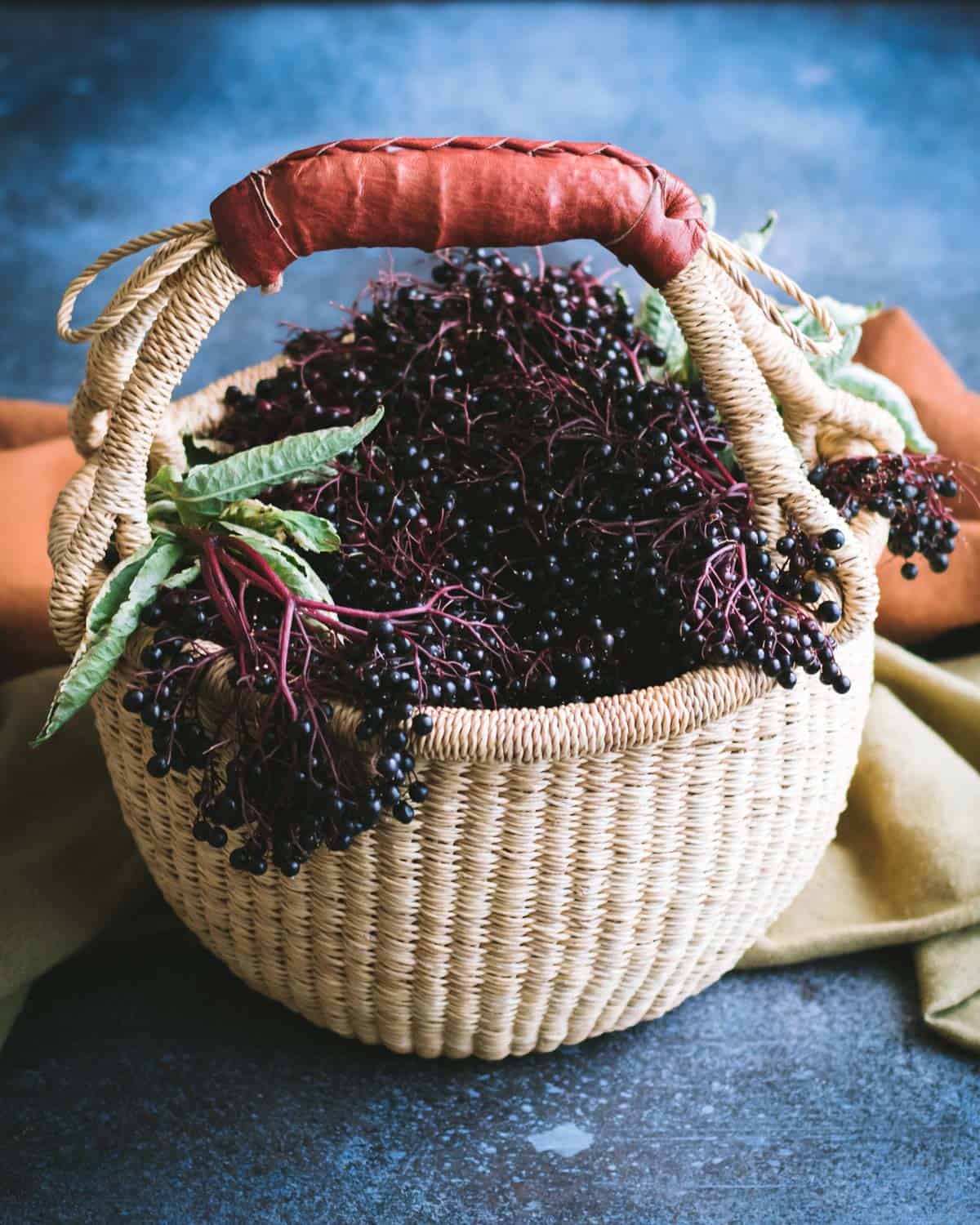
Herbal Uses of Elder
Elderflowers and elderberries are both recognized for their potent herbal properties, which herbalists have honed for centuries.
Uses of Elderflower
In traditional herbalism, elderflower is a longstanding and popular ingredient in skin creams and salves, and with good reason!
The flowers are well-known among herbalists for their calming properties, especially for itchy or irritated skin (I love to use them when making herbal salves for personal use or gift-giving).
You can also make a fever-reducing elderflower tea, which herbalists use to induce sweating to lower body temperature.
Get more winter wellness recipes for teas, infusions, syrups, honey ferments, oxymels, and gummies in my ebook Herbal Immune Support: Homemade Recipes for Wellness!
Uses of Elderberry
Elderberries have numerous uses in traditional herbalism due to their potential immune-boosting benefits. Herbalists often use dried or fresh berries to make elderberry syrup, which can be taken with raw honey and ginger at the onset of sickness.
Studies have shown that elderberries have a significant effect on reducing the duration of colds and their associated symptoms.
Elderberries contain polyphenols and lectins, which have been shown to give them the ability to inhibit coronaviruses. Although further studies are needed, the antiviral properties of elderberries have also been linked to reducing the duration of influenza.
Elderberries can also be made into a tincture, tea, oxymel, fermented honey, or gummies. These are all simple ways for a practicing herbalist to access the herbal goodness of these wild berries.
Herbalist wisdom suggests that elderberries may overstimulate the immune system if taken in excess or when not necessary. Many herbalists don’t recommend consuming elderberries when you aren’t experiencing any cold and flu symptoms, or if you have an autoimmune disorder.
It’s crucial to research before consuming any herbal remedy, and consult a doctor or a trusted herbalist to make sure you are using it appropriately for your own health needs.
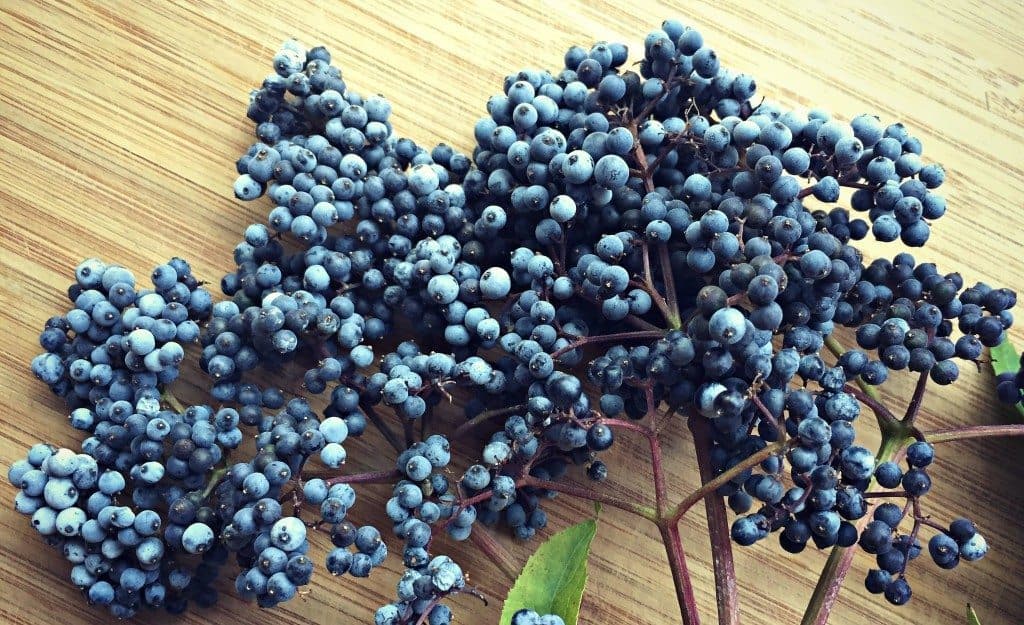
Grow Your Own or Buy Elderberries
Elderberry is such a great plant to have around for so many different reasons. It’s easy to identify and usually grows prolifically.
We grow elderberry from root cuttings right in our backyard!
For its herbal uses alone, it’s a plant I wouldn’t want to be without. When you factor in its edible berries and its wine-making abilities, I now want tons of them!
Luckily elderberries are easy to forage and grow.
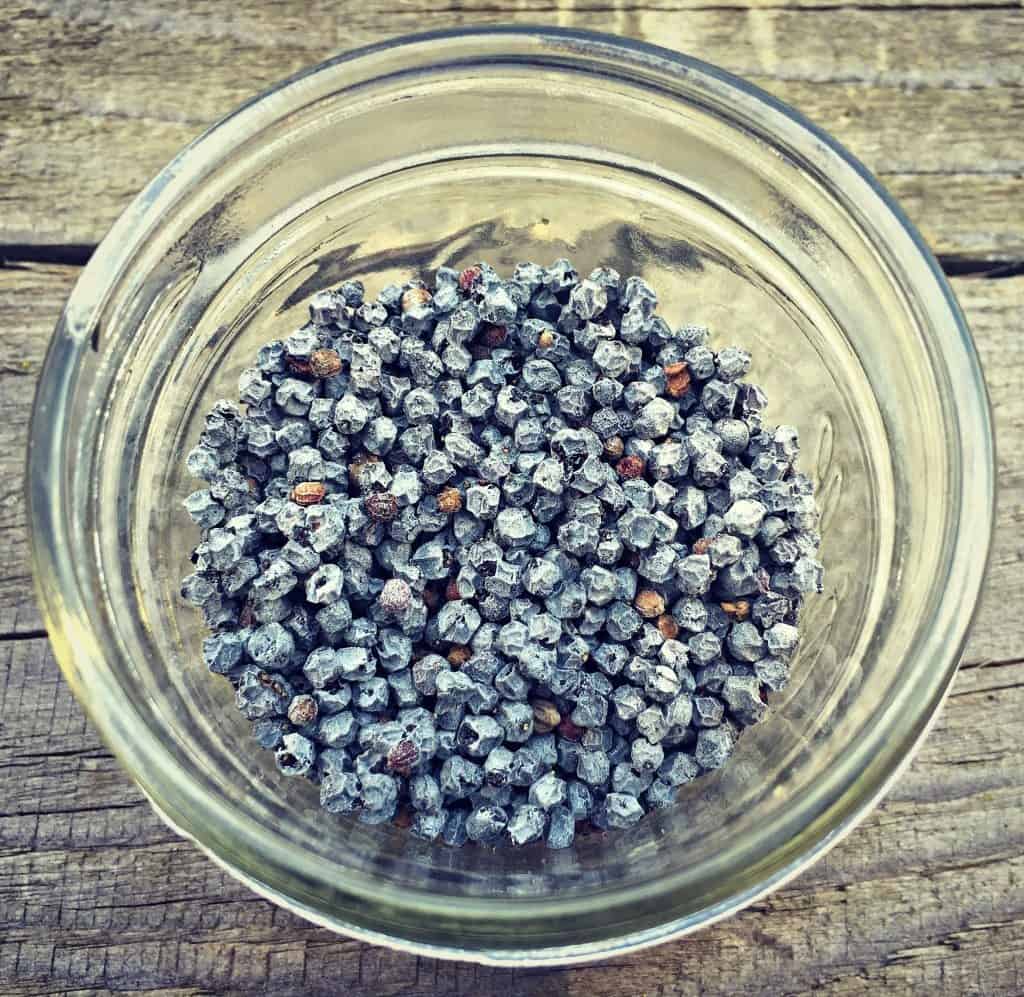
If you can’t find any elderberries, or if it’s the wrong season, you can always buy dried elderberries or elderflowers from Mountain Rose Herbs (my favorite place to buy high quality, organic dried herbs).
Time to start foraging for elderberries and elderflowers!

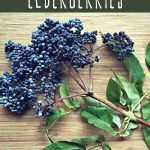

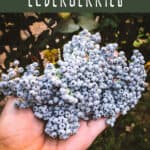
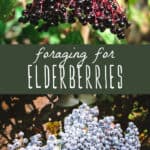
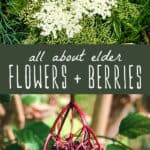

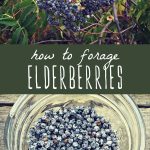
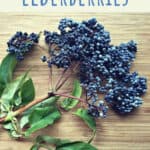
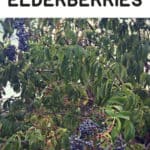
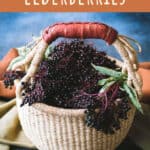
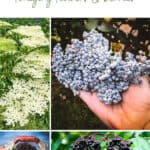
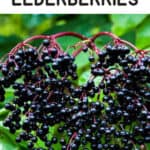
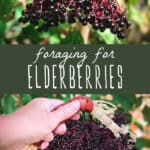

So I have a question regarding something I read on the farmers almanac website. It stated “only pick elderberries that are drooping, not upright”. I figured maybe it was speaking about dwarf elderberries, but it didn’t elaborate. I live in the PNW, is that something I need to keep an eye out for when harvesting blue elderberries?
Yup, that’s a good indication to start picking them.
Thank you! I legit was about to pick pokeweed thinking it was elderberries! Excellent information! It was satisfying to get a comprehensive article and also the information about lookalikes!
I’m waiting for my elderberries to ripen and look forward to using them to make syrup and other things.
I’d like to take cuttings and start more.
Is there any particular thing I need to know to do this.
Thanks so much
Hi Cindy. Please see my post on how to grow elderberries from cuttings here.
My elderberries are starting to ripen, but there are still a lot of green ones, too. Can I pick the dark purple/black ones while there are still green ones, or should I wait for full bunches to ripen? The birds are already picking off a lot of the ripe ones!
It’s best to wait until they’re all fully ripe. Cover it in bird netting if you’re worried about the birds getting them all!
We have a Sambucus Black Lace which has dark leaves and pink clusters of tiny flowers. Are those flowers usable/edible like the white ones? I’ve not seen any berries on this tree, so I don’t know if it should produce berries or if it is simply a flowering variety.
Yes, you can use them the same way! Enjoy!
You need a second plant to cross pollinate in order to get the berries.
I picked a bunch of elderflower sand dried them. I cut the big parts off stem off but left the small stems. Should I be picking out All the stems so there are only the flowers?
Hi Sandi. You’ll want to use only the flowers as the stems are toxic.
You mentioned “Pokeweed”, yes the Berries are Toxic! But the “Young Plant” is edible. Best harvested in the Spring. Steamed and topped with ACV or Red Wine Vinegar, is the Best. You can cooked the Stem & Leave. Taste close to Lamb’s Quarters or Spinach. Need to harvest, before the stalk turns Red.
I’ve also been told to harvest only the ones 18 inches or under
Have you heard anything about that ?
I usually only harvest the ones that are 15 inches or less. That is for tenderness. When they get larger they can get tough. Mom always cooked the stems like she cooked okra. Coat them in flour and fried. My wife’s family ate the leaves cooked with their scrambled eggs.
Thank you for the great post! I usually only find posts for black elderberry. We have 40-50 blue elderberry growing on our property. The numbers are growing all of the time, and the last time I stood on my porch and counted what I could see from there, I counted 36. So really, the number is likely a lot more! We just got two in our back yard for the first time two years ago. Up until then, they only grew on ⅔ of our property. I have never harvested any of the berries or flowers because I was unsure when the berries were ripe. I have wanted to make some syrup, and my husband has been wanting to try and make some wine. Thank you so much for your very informative post!!
A few years ago I had our yellow jacket collector mention that he had never seen so many blue elderberry on one property before. He harvested a few bagfuls, and later came for a few cuttings for a client’s property. I am so thankful to have found your posts. I cannot wait to learn more.
Hi Nassra! Wow, 40+ blue elders is a lot. I don’t think I’ve ever seen that many on one property either! I can only imagine how many bottles of wine and elderberry syrup you could make from them!
Hi! I was wondering if you could help with avoiding or dealing with eggs/larvae from forged elderberry?? I opened my drawer the order day only to find moths in my freezer bag! I know that is normal but how can I prevent this in the future?
Thank you.
Hi Jessica. I haven’t ever had that happen. Make sure to wash them really well before storing!
I just saw your response to Elena. Thank you!
A friend gave me a large bag of elderberries, however they’re covered with a white chalky coating. Can’t find anything that resembles them. Are the really elderberries?
Those are fine. Its is typical to have the white powdery residue.
I found a bunch of elderberry trees around the area I live near Eugene Oregon ( heading west to the coast) The problem I keep running into is that the berries are to high in the tree for me to get to! Any ideas ?
I usually use a long stick to pull the branch down low enough to reach them.
I use a garden hoe to carefully pull down branches or a wide slotted rake. Works great.
Thank you for this informative post. I have a couple small blue elderberry plants and wanted to harvest their berries… the berries are now covered with the whitish yeast and look quite ripe to me, but I read elsewhere that the berries are only ripe when you squeeze one and the juice is purple… when I squeeze these, the juice is a light color, not purple at all. Does that mean they’re not yet ripe? (Or does the purple juice test only apply to the black elderberries?) – Thanks!
Hi Elaina, blue elderberries have a very light purple or clear juice. If the berries themselves are purple beneath the yeast blooms, they’re ready for gathering.
i just picked some elderberries and there all pretty black but some where almost all black with just some tints of red would that still be considered ripe enough, most of it looked fully ripe. thankyou
I Emily. It’s really hard for me to say without seeing them, but as long as they’re soft and juicy, they’re probably ripe.
Elderberry syrup, and the tea I made regularly for many years in a row were fantastic. I would recommend it to anyone. I didn’t use the berries because someone always picks them before me. If someone is making a mixture of teas or tinctures for immunity, elderberry is also welcome.
Thank you. I planted elderberry and many other new plants and didn’t know which were elderberries. Your article helps. I also did not know the leaves, stems, and unripe berries were toxic!
You’re welcome. I hope you enjoy your elderberries!
I have really large trees that tower over other trees but I believe they are elderberrys, the flowers look the same but I never see any berries after the flowers. Do elderberries grow this large? At least 40 feet and taller.
Hi, Connie. Mature elderberry trees don’t typically grow taller than 12 feet. They’re more of a shrub in their appearance.
There is a massive, very old, elderberry tree by our home that we think must be close to 100 years old. I just harvested from it today. I think this is unusual to find one this old, but it is possible.
Any idea where I could find some elderberry cuttings around SW Florida. Thanks
I’m sorry, I don’t. I am in Oregon.
Richters has plants for sale. They are out of Canada. Very reliable.
I harvested some elderberries on our land in Tn, some were still green in my large batch that I boiled for syrup. I just read they are toxic when not fully ripened, should I throw out the first batch? There were about a handful of green ones in 1.5 cups of berries
Hi Jessi, if they were boiled very thoroughly with the lid off so that steam could escape then you should be fine. I would start with small doses when you take the syrup, and if you feel any upset stomach after taking it then you may not want to use it. Some people are more prone to feeling the effects than others.
I had this same question. Although i picked most of them out. There are some that have a small spot of green, but mostly deep purple /blueish. I plan to make a syrup AND a tincture.
I read that it is safe to eat the semi-green ones if cooked down.
But what about the tincture ? Since its being extracted without heat?
Thank you!
Hi Emily. If you picked most of them out, it should be totally fine for use in a tincture.
very important to also mention that only the black and blue elderberries are safe to use– Red elderberries have a cyanide-like compound that makes them toxic, though the flowers from red elder can still be used. I was surprised you didn’t list that in your look-alikes as that is the most common mistake beginners are likely to make
Hi there, every time I mention red elderberries in the post I say that they are toxic when raw and need to be cooked prior to eating. I don’t really consider them a look-alike to blue or black elderberries being that they are red in color.
Are they really toxic? Apple seeds have cyanide
Yes, elderberries should always be cooked prior to consumption.
Hello Colleen, I believe you mentioned that some elderberries are not good to eat. How can they be distinguished from the edible variety? If you’ve made mention of this somewhere in the article, then I just missed it and please forgive me.
I live in Texas, just for reference.
Thanks
Hi Bryan, red elderberries are toxic when raw and shouldn’t be consumed unless thoroughly cooked.
I live in the San Francisco bay area. The east bay to be exact. I’m wondering if anyone has any advice for where to look here. Up towards the Sierra Nevada mountains maybe? Really hoping to find some closer. Any advice would be appreciated. Thank you!
Hi there, yes they can be found in the Sierra Nevadas (I used to live there, they are actually quite common). Check in the 3000-6000 foot elevation range, they will be flowering in June/July and berries should be ripe by late August or September. You might also find them in the woods around your region in the bay area, they would most likely be blooming now (May). Hope that helps!
Hey Maureen, I’m in Oakland and I recently found some (by happenstance) at the end of a parking lot near Home Depot in Richmond (nearest the highway).
Where can I get some blue elderberry cuttings to start ?
Unsure how to begin looking for them where I live in South Carolina, if anyone has insight…TIA!
In KY, it’s easy to find them growing on older stock fences. They grew along my grandfather’s barn in abundance.
I live in South Carolina and they are EVERYWHERE! They grow abundantly in the Summerville area on the sides of roads.
I just moved to Summerville SC…I would love to find a wild location!!
I live in the PNW. I’ve been reading in late August early September is when they are ready to harvest. I’ve recently found a large group of Elderberry plants that are full of berries. I’m having a hard time figuring it if they are ripe or not. Most are covered in the white powder but when squished don’t produce a reddish colorful juice. How do you determine their ripeness?
I’m wondering if you have any methods for sifting out the little stem pieces…. Drying them helped to have the berries naturally fall off, but there are still little pieces of stems. I’ve been picking them out but it is tedious so I’m wondering if you’ve got any tips? :)
Hi Nico. You can try putting your elderberries in a bowl and covering them in water. The little bits of the stem will float to the top and can be easily skimmed off.
Please make sure people understand that there are look alike in many areas that are very toxic.Be 110% sure what you are picking is really Elderberry especially. If you pick them along the highway you must ask the owner of the land before picking. In some States a person in the country owns out half way into the road so any plant growing is theirs.
ive read that the flesh of the berries have to be deseeded, because the seeds are toxic
Where do you find them growing?
I live at the Maryland/Pennsylvania border and the black elderberries grow not far from ponds or streams. I foraged 2 bushes this year, fairly small ones and only got enough to make a qt. of tincture. Those bushes were about 35 feet from a small pond at the corner of the cow pasture. The Western elderberries trees grow much larger…up to about 25-30 feet I think. You can buy them online in a dried form and tinctures can be made with those….and you only need about 1 cup of dried berries to make a Qt. of tincture. The cost is about $15-$16 a pound. I don’t know how many cups that makes but my guess would be about4-6 cups.
I like the idea of tincture….
Western Pa….